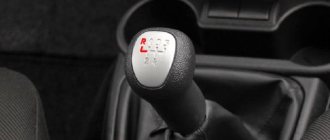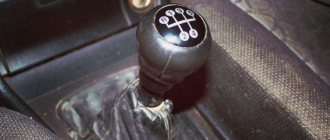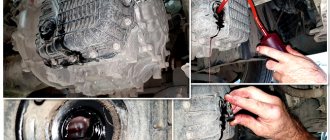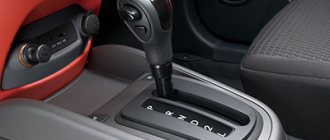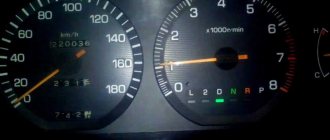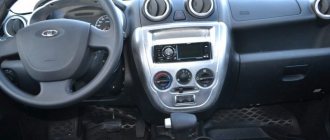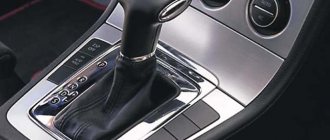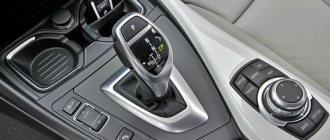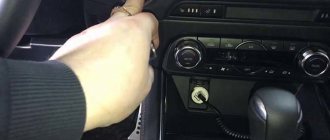How to engage reverse gear
The first, second and even fifth gear is engaged, but there is no way back? If you have a manual transmission, then depress the clutch, push the gearshift lever down and engage reverse gear. For those who would like to learn in more detail about how to properly use reverse gear in different gearboxes, this article is intended.
Manual transmission: sequence of actions
1. Under no circumstances try to engage reverse gear at high engine speeds. Structurally, the gearbox is designed in such a way that the synchronization of rotation of the gearbox gears is significantly worse than when engaging a gear to move forward. 2. Turning on moment. On different manual transmissions, the reverse mode can be activated differently. Perhaps the lever needs to be pressed down - without this the speed will not turn on. How to turn on reverse gear on your car - read in the car manual. General recommendations: do not try to apply significant force - this will inevitably lead to breakdown of the manual transmission. 3. Engine idle speed is the law. Set the car to the parking brake, press the clutch pedal, and engage reverse gear. Next, look carefully using mirrors; for beginners, it would be a good idea to turn the body and look around without the help of mirrors. Then everything is simple - start moving.
Automatic gearbox: sequence of actions
1. On an automatic transmission, the reverse mode is usually indicated by the letter R. To engage reverse gear, simply move the lever to the appropriate position and start driving. 2. On an automatic transmission, it is worth taking into account the fact that, due to the design features, you can inadvertently engage reverse gear when moving forward. On new models there is a lock, but on older ones this is possible. Be careful - if this happens, the automatic transmission will fail. 3. For automatic transmissions, the same rules apply as for manual transmissions - switching occurs only at idle engine speed.
Wear of the rocker bushing
This malfunction may be indicated by some looseness of the lever. However, if the wear proceeded evenly - it ran its course - you could get used to the free movements of the scenes and not notice the impending troubles. The problem is solved by replacing the bushing - remove the lever cover, then remove the rocker itself, replace the plastic bushing with a new one and put everything in place. The procedure is carried out in the car interior.
What to do if reverse gear does not engage
1. If noises and grinding noises are heard: turn off the engine and stop trying to turn it on - the gearbox or clutch has failed. The solution is to contact a specialist, or push the car out and drive to the nearest workshop, without engaging reverse gear. 2. If there are no extraneous sounds when you turn it on, but you can’t turn it on, try again, taking into account the characteristics of your car: perhaps you do not recess the lever, or do not move it to the side enough. And lastly: any actions to turn on the speed must be carried out with the clutch pedal depressed.
Read how to adjust the gear shift control drive on a VAZ 2110. A diagram of the device is presented.
If during operation of the car you have problems with gear shifting (there is no clear shift), then it’s time to adjust the drive that controls this mechanism. Also, this work must be carried out immediately after you have removed the gearbox, repaired it and reinstalled it, since after such actions the entire gear shift mechanism “diverges”.
We did the setup on a VAZ 2110 car.
Old gearbox oil or low level
If the car is not new, then who knows if the gearbox oil was changed and when? You need to change the oil and pray that something worse doesn't happen. If there is a leak, drop by drop a day and you may not notice how the oil leaks out of the box. As a rule, this happens through the gearbox gasket or shaft seals. Over time, the box reacts to this with increased noise, but you might not have noticed this either. It is better to change the oil and replace gaskets with seals at a service station, or on your own if you have a “green” understanding of what you are doing.
Adjusting the gear shift control drive
| 1 — reverse locking bracket; | 8 — spherical pin of the gear shift mechanism; |
| 2 — axis stop; | 9 — body floor; |
| 3 — gear shift lever axis; | 10 — ball joint; |
| 4 — axle bushings; | 11 - buffer; |
| 5 — VAZ 210 gear shift lever; | 12 - spring; |
| 6 — spacer sleeve; | 13 - template 67.7834.9527; |
| 7 — spherical washer of the ball joint; | 14 — bracket cover. |
2. In order to ensure free movement of the rod relative to the gear selection rod, the grooves at the end of the rod and the clamp should be widened using a screwdriver. Then place the rod in the neutral position.
3. Next, we go into the car interior and remove the gearbox cover from the handle. You can simply lower it to the very bottom, and install the lever so that its lower (non-bent) end is approximately vertical.
If you have template 67.7834.9527, then set the gear shift knob as follows: with the lever cover removed, install the template in the trim window (number 14 in the diagram above) of the reverse locking bracket.
Next, insert the stop of the axis (2) of the lever (5) into the groove of the template (13) and press it against the template in the transverse direction without causing elastic deformation of the bracket (number 1). Lock the lever (5) in this position.
4. Under the bottom of the car, you need to carefully, without sudden movements of the hand, select the axial play of the rod in the rearward direction and its angular play in the counterclockwise direction (the task is not to move the gear shift lever).
Adjusting the position of the gear shift lever
Read how to adjust the gear shift control drive on a VAZ 2110. A diagram of the device is presented.
If during operation of the car you have problems with gear shifting (there is no clear shift), then it’s time to adjust the drive that controls this mechanism. Also, this work must be carried out immediately after you have removed the gearbox. its repair and reinstallation, since after such actions the entire gear shift mechanism “diverges.”
We did the setup on a VAZ 2110 car.
how to change gears on a VAZ 2110
Before moving off, carefully study the gear shift pattern and practice shifting gears with the engine not running. Gear shift diagrams are shown in Fig. 1. Using the gear shift lever, the driver can discretely transmit torque from the engine to the wheels of the car. The first gear is the most powerful, transmits the highest torque and is used for starting from a standstill, overcoming difficult sections of the road, and when driving uphill with a large load.
The speed in this gear is up to 40 km/h. Second, third and fourth gears respectively transmit less torque. The crankshaft rotation speed decreases, and the wheel rotation speed increases. The second gear is used to accelerate the car and move it at speeds from 20 to 60 km/h. The third gear is used to accelerate and move the car at speeds from 30 to 90 km/h. Fourth gear (direct) creates less torque and has the largest speed range, from 40 km/h to maximum.
The fifth gear has a reduced gear ratio of 0.70.8. The crankshaft rotates at a lower speed than the wheels. This economical transmission is used for straight sections of the road, without heavy loads, since it is very weak. The reverse gear is also powerful and transmits a lot of torque and has a large gear ratio. It is used for reversing. The neutral position of the gear shift lever disengages all gears.
To engage reverse gear, press the clutch pedal and, after holding for 3 seconds, press the gear shift lever all the way and move it to the reverse gear position. Everyone must learn to move a car away smoothly in compliance with a certain sequence, safety requirements and traffic rules. A little theory. When moving, a car overcomes a number of forces that create resistance to its movement.
The main forces are: the rolling resistance force of the wheels, the air resistance force, the inertia force and the lifting resistance force. The movement of the car is ensured when the adhesion force between the wheels and the road is equal to or greater than the traction force. If the traction is greater than the traction force (the ten has more traction force than most other domestic cars), then the drive wheels will slip. In this case, a large load is placed on the clutch and gearbox, which can quickly fail. Fans of a sporty driving style should especially remember this. On the 10, the gearbox is not from a Mercedes.
When starting off on a flat section of the road, you only need to overcome the rolling resistance force of the wheels and the force of inertia. Before you set off, you must: depress the clutch pedal (develop this habit, it will allow you to avoid many troubles); turn on the ignition; start the engine; carefully inspect the road you intend to enter through the rear-view mirrors, external and internal, and turn your head left and right to check the blind spot from behind and from the sides; Turn on the turn signal if you are sure it is safe. You should not turn on the turn signal if there are other vehicles or pedestrians nearby to whom you must give way; With your left foot, fully depress the clutch pedal and hold it in this position.
The clutch pedal must be pressed sharply, this disengages the clutch, disconnects the rotation of the crankshaft and the input shaft of the gearbox; Hold the steering wheel with your left hand, and with your right hand move the gear shift lever to the first or second gear position (when it is necessary to engage second gear, we will consider below). Comment. The first (second) gear may not engage immediately; there is no need to try to push it in by force. Move the gear shift lever to the neutral position, release the clutch pedal, depress the clutch pedal all the way again and repeat engaging the first (second) gear. At the same time, the gears of the gearbox have turned and the gear should engage easily; again carefully inspect the road through the mirrors and left shoulder, make sure it is safe once again; If you can start moving, then release the parking brake lever down; lightly press the gas pedal with your right foot; feel the crankshaft speed increase slightly.
This is especially clearly visible on the tachometer; With your left foot, slowly and gently release the clutch pedal, gradually turn it on and smoothly transmit torque from the engine crankshaft through the first gear of the gearbox to the wheels, while the crankshaft rotation speed from the load will begin to decrease. You can hear it from the engine noise or see it from the tachometer; hold the clutch pedal at the end and lightly press the gas pedal, increasing the crankshaft speed and traction force, which begins to overcome the rolling resistance of the wheels and the force of inertia; the car starts moving smoothly; After starting to move, continue to smoothly release the clutch pedal all the way, then be sure to remove your foot from the pedal. The clutch pedal in first gear must be released smoothly, held at the end, and then smoothly released to the end. When starting off, drivers mainly make two mistakes, which lead to a strong jerk or stopping of the engine. Reasons for the first error. sharp release of the clutch pedal and strong pressure on the gas pedal (high crankshaft revolutions lead to a strong jerk of the car, and on a slippery road and for drivers with a sporty driving style on dry asphalt, it leads to wheel slipping). Eliminating the error if the engine does not stall: sharply depress the clutch and reduce the pressure on the gas pedal and reduce the crankshaft speed.
Repeat the move. Pay attention to the smooth release of the clutch pedal and less pressure on the gas pedal. Reasons for the second error. sharp release of the clutch pedal and weak pressure on the gas pedal, crankshaft revolutions are low. Error elimination: restart the engine. At the same time, pay attention once again to the smooth release of the clutch pedal and the stronger pressure on the gas pedal compared to the first attempt.
When using two clutch and gas pedals in concert, lightly pressing and releasing the gas pedal should always be slightly ahead of pressing and releasing the clutch pedal. It’s easier to get moving in the top ten with the 2112 engine installed. When starting off, you don’t have to press the gas pedal. This makes management easier. The car picks up speed without high revs. And the traction reserve allows you to change gears less often.
Is it possible to instantly break a machine gun?
With automatic transmissions the situation is a little different. There, the transmission of torque is carried out due to the planetary gears, and they are always in mesh. That is, the design of the box allows you to activate reverse at high speed. Therefore, manufacturers tried to protect these transmissions as much as possible from accidental conversion to R.
Question answer
Is it dangerous to drive for a long time in neutral in manual cars? A stopper was placed on the selector, as well as on the box itself. But if the lever is pressed hard (on the verge of breaking), it is possible to activate the reverse. Then the shaft begins to rotate in the opposite direction, and then everything depends on the reliability of the mechanics. If the machine is designed to withstand a large torque, then it will turn the shaft in the opposite direction and at high speed. Such units are usually installed on powerful pickup trucks and SUVs with a longitudinal transmission and engine.
But in passenger cars, the automatic transmission is designed for a lower torque, and during such strength tests, the gear shift mechanics can be damaged. If you push the lever with force, the machine will try to go into R, but there will be a crunching and twitching sound. The car will continue to move forward, but the gearbox will no longer be viable. Then it’s a straight road to technical service for expensive repairs. But only very desperate people can deliberately break machines like this.
However, with the advent of electronic control, the safety of machines has increased significantly. The rocker lever no longer has a direct mechanical connection with the transmission, and commands to turn on one or another mode are given via wires. The control unit receives information about the operation of the engine, the speed of the car and other driving parameters and will not activate reverse, even if the lever is moved to R. The box will go into neutral.
